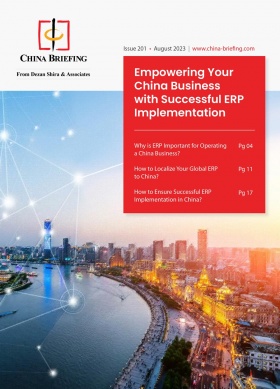China’s Pivot from Energy Consumption to Carbon Emissions Controls: Impact on Companies
China is pivoting on one of its key decarbonization mechanisms by shifting focus from reducing total energy consumption to reducing total carbon emissions. Policymakers hope that this change will more closely align China’s carbon reduction strategy with its “dual carbon” goals of reaching peak emissions by 2030 and carbon neutrality by 2060. The pivot also has profound implications for companies operating in China, presenting both challenges and new opportunities for green industries.
In July 2023, the Central Committee for Comprehensively Deepening Reform (CCCDR) reviewed and passed the Opinions on Promoting Dual Control of Energy Consumption and Gradually Shifting to Dual Control of Carbon Emissions. These opinions, which have not been made public, outline how China will gradually shift from its policy approach from the “dual energy consumption control” mechanism for decarbonization to the new “dual carbon emissions control” mechanism.
The “dual energy consumption control” mechanism refers to the policy of controlling total energy consumption and controlling the energy intensity of regions, industries, and companies, while the “dual control of carbon emissions” mechanism instead focuses on controlling total carbon emissions and carbon emissions intensity.
This change, which will be implemented gradually, has significant implications for China’s overall decarbonization strategy, as well as for individual companies and entities operating in the country. The new mechanism will at once help to remove caps on energy consumption for energy-intensive industries, thus giving critical raw material industries space to grow, while promoting the shift to renewables.
Below we look at how the new mechanism will work, and discuss the benefits, opportunities, and challenges for companies operating in China.
What is the dual control of energy consumption mechanism?
The “dual control” of total energy consumption and energy intensity mechanism was developed over the course of several years. The mechanism has been implemented in some form since being introduced in the 13th Five-Year Plan (FYP) in 2016. The strategy has been developed over the course of several policy documents in the years since, such as the Plan for Improving the Dual Control System of Energy Consumption Intensity and Total Energy Consumption, released in September 2021.
The dual control mechanism became a central strategy for China’s “dual carbon” goals— reaching peak carbon emissions by 2030 and carbon neutrality by 2060—which were officially set by President Xi Jinping at the United Nations General Assembly in September 2020.
The 14th FYP, released in March 2021, calls for “improving the dual control of total energy consumption and intensity, focusing on controlling fossil fuel consumption”.
The FYP also calls for “implementing a system that focuses on carbon intensity control and is supplemented by total carbon emission control”, and promotes “clean, low-carbon, safe and efficient use of energy, and further promotion of the low-carbon transformation in industry, construction, transportation, and other fields”.
Under the dual control mechanism, China aims to decrease overall carbon emissions by controlling total energy consumption and the consumption intensity of companies and projects. It involves setting energy use “budgets” at the provincial level (or the municipal or regional level for municipalities and autonomous regions). The provincial government is then tasked with prioritizing energy resources for core applications, such as residential use, modern services, high-tech industries, and advanced manufacturing while tailoring strategies to control fossil fuel consumption.
Why is China’s focus changing from energy consumption to emissions control?
The dual control of energy consumption mechanism has come under review in the years since China’s announcement of its dual carbon goals in 2020. The pivot has also been mentioned several times in various policy documents. For instance, the readout of the 2021 Central Economic Work Conference (CEWC), which sets the economic blueprint for the following year, called for transitioning “from ‘dual control’ of energy consumption to ‘dual control’ of total carbon emissions and intensity as soon as possible”.
In the years since China’s announcement of its dual carbon goals, several shortcomings of the dual energy consumption control mechanism have been revealed.
One shortcoming is that a focus on reducing energy consumption and energy intensity will inevitably encompass the consumption of non-fossil fuel energy, such as nuclear and renewables. In renewable-rich areas, this mechanism could even suppress the use of renewables. The 2021 CEWC also acknowledges this issue, stating that “it is necessary to scientifically assess that new renewable energy and raw material energy use will not be included in the total energy consumption control”.
Meanwhile, the focus on total energy consumption also includes the energy consumed for the production of raw materials, which has relatively rigid energy requirements. By limiting the amount of energy consumed, these types of intrinsically energy-intensive but necessary industries are heavily impeded, even if efforts are made to switch to greener energy.
The switch to focusing on dual control of carbon emissions will therefore help to incentivize the use of renewable energy while also anchoring the country’s core emissions reduction strategy directly to its dual carbon goals.
How will China shift to dual control of carbon emissions?
The shift from dual control of energy consumption to dual control of carbon emissions will be a gradual one and is already underway.
In a statement posted on the NDRC website, the Director and Spokesperson of the Policy Research Office of the NDRC Jin Xiandong stated that the Opinions, which have not yet been publicly released, propose a step-by-step plan to implement and promote this transformation. Further, the work of transitioning to the new mechanism will be promoted from three aspects.
First, recognizing that the transformation will not be accomplished overnight, the statement says that it is necessary to make use of the achievements that have already been made through the dual energy consumption controls and make a “smooth and orderly transition to dual carbon emission controls”. During the process of transitioning, work will be carried out to improve support systems, such as the carbon emissions statistical accounting system, as well as carbon management systems. Jin’s statement makes it clear that the implementation of dual carbon emission controls “does not mean any relaxation of energy conservation work”.
The second aspect of the transition concerns the need to continue improving energy conservation capabilities by “implementing a comprehensive conservation strategy, continuously improving energy utilization efficiency, and promoting sustained and healthy economic development at the minimum [energy] cost”.
The third and final aspect involves striking a balance between development and the reduction of emissions. This means that the reduction of emissions must be carried out while effectively guaranteeing crucial elements of the economy and society, such as food security, energy security, and industrial chain supply chain security, as well as preventing disruption to people’s livelihoods.
Opportunities and challenges for companies under dual emissions controls
The shift to carbon emissions controls will present a range of benefits and opportunities, as well as various challenges, to companies operating in China.
For instance, the pivot to controlling the total carbon emissions of a region or an entity will require a high degree of emissions monitoring on the part of both governments and companies.
Under China’s current carbon trading rules, companies are required to disclose accurate information on their greenhouse gas (GHG) emissions. The collection and analysis of emissions data will require the allocation of additional resources and may therefore increase operational costs for companies. At the same time, implementing the tools and mechanisms for reducing carbon emissions and improving energy conservation may also be costly and time-consuming. This could be burdensome for companies that have not already begun accounting for the costs of reducing their carbon footprint in their business plans.
However, the shift is also poised to bring several benefits to companies and will help to grow demand for green industries.
First, environmentally conscious companies will benefit from the change as it will help to make the renewables market more competitive. Companies that are already seeking to reduce their reliance on fossil fuels due to global climate pledges will therefore be able to increase their consumption of renewables without exceeding energy consumption controls, as would be the case under the total energy consumption controls.
Meanwhile, high-energy consuming companies will no longer be restricted in the amount of total energy that they can use, if they are striving to reduce their reliance on fossil fuels and improve energy conservation over the longer term. The limits on energy-intensive industries also inhibited these industries’ overall development, and by extension also the economic development of various regions that are reliant upon these industries in China. The change could therefore provide a much-needed boost to resource-rich regions that rely on energy-intensive industries for economic growth.
Companies will also have more flexibility in the types of mechanisms they can employ to reduce energy consumption and thereby reliance on fossil fuels, as the end goal is to reduce total carbon emissions, rather than overall consumption. This will allow companies to utilize various tools, such as carbon credits and emissions reduction technology.
The shift is also good news for companies operating within the renewables industry, as well as carbon asset management and financial companies. With companies and other entities under increasing pressure to decarbonize, demand for energy conservation and carbon reduction products and services will increase, presenting a significant growth opportunity for these industries.
About Us
China Briefing is written and produced by Dezan Shira & Associates. The practice assists foreign investors into China and has done so since 1992 through offices in Beijing, Tianjin, Dalian, Qingdao, Shanghai, Hangzhou, Ningbo, Suzhou, Guangzhou, Dongguan, Zhongshan, Shenzhen, and Hong Kong.
Please contact the firm for assistance in China at china@dezshira.com. Dezan Shira & Associates has offices in Vietnam, Indonesia, Singapore, United States, Germany, Italy, India, Dubai (UAE), and Russia, in addition to our trade research facilities along the Belt & Road Initiative. We also have partner firms assisting foreign investors in The Philippines, Malaysia, Thailand, Bangladesh.
- Previous Article Chiusura dei conti bancari in Cina per cessazione della società: Nuove indicazioni e suggerimenti
- Next Article China’s Golden Week Boosts Consumption, Showing Positive Economic Signs








